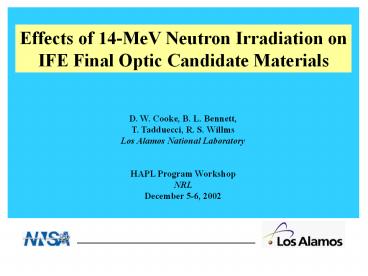Effects of 14-MeV Neutron Irradiation on
1 / 11
Title:
Effects of 14-MeV Neutron Irradiation on
Description:
fast fission reactor with high- energy tail. High fluence = 1.4 E17 n/cm2 ... Thermal annealing to 675 K reduces abs. Neutron-induced absorption is similar ... –
Number of Views:40
Avg rating:3.0/5.0
Title: Effects of 14-MeV Neutron Irradiation on
1
Effects of 14-MeV Neutron Irradiation on IFE
Final Optic Candidate Materials
D. W. Cooke, B. L. Bennett, T. Tadduecci, R. S.
Willms Los Alamos National Laboratory HAPL
Program Workshop NRL December 5-6, 2002
2
Experimental Details
Commercial D-T generator 3.0 mA beam current and
160 kV 90 molecular ions therefore, 80 keV eff.
beam energy Angular distribution 14.68 MeV _at_
0, 14.06 MeV _at_ 90, 13.47 MeV _at_ 180 Neutron
fluence measured by Al and Fe activation
foils Neutron output 3.0 E10 n/s Total neutron
fluence on samples CaF2 and mirror 1.1 E15
n/cm2 Fused silica 6.3 E13 n/cm2
3
Neutron Irradiated Dielectric Mirror
14.7 MeV neutrons Fluence 1.1 E15 n/cm2
Laser-line MAX-Rdielectric mirror Proprietary
material on fused silica substrate 25 mm round x
6 mm thickness Design wavelength 351 - 355 nm (0
incidence) Specified reflectance ? 99
Reflectance measured at 7
NO MEASURABLE EFFECT
4
_at_ design wavelength (331 - 335 nm) R 99.6 0.4
NO MEASURABLE EFFECT
5
Neutron-Irradiated Fused Silica
Fused silica from CVI Laser (11.7 mm diameter,
2.2 mm thickness) Peaks are due to overtones of
fundamental OH stretch mode 14 MeV TSL
corresponds to thermal annealing to 675 K (no
defects to anneal) No measurable neutron induced
absorption (E 14.7 MeV fluence 6.3 E13
n/cm2)
6
Related Result
LASREF irradiated silica fibers Neutron spectrum
typical of fast fission reactor with
high- energy tail. High fluence 1.4 E17
n/cm2 Low fluence 1.1 E19 n/cm2 Low OH (lt 1
ppm) silica fiber SIGNIFICANT NEUTRON INDUCED
ATTENUATION
7
Neutron-Irradiated Crystalline CaF2
CaF2 from Saint-Gobain Total neutron fluence
1.1 E15 n/cm2 F-band _at_ 385 nm M-band _at_ 550
nm Thermal annealing to 675 K reduces
abs. Neutron-induced absorption is similar to
x-ray-induced absorption
8
X-irradiated Crystalline CaF2
X-ray exposure 8.75 kGy (in air) Effective
energy 25 keV F and F-aggregate centers are
readily induced.
9
Comparison of Neutron- and X-Irradiated CaF2
General consensus is that pure CaF2 is not
amenable to radiation induced absorption, but is
readily damaged if it contains trace amounts of
trivalent (rare-earth) impurities. Conclude
that present material contains trace amounts of
impurities.
10
Conclusions Derived From Present Results
Multilayer dielectric mirror Exposure to 14.7
MeV neutrons of total fluence 1.1 E15 n/cm2
yields no measurable effect on reflectance
spectrum and no obvious physical damage. Good
IFE candidate material. Fused silica Exposure
to 14.7 MeV neutrons of total fluence 6.3 E13
n/cm2 yields no measurable effect on optical
absorption. Spallation neutrons induce
significant absorption in fused silica fibers.
Possible IFE candidate material. More research
needed. Single-crystal CaF2 Exposure to 14.7
MeV neutrons of total fluence 1.1 E15 n/cm2
yields significant optical absorption. Similar
results are obtained by x irradiation (8.75 kGy
in air). Crystals may contain trivalent
(rare- earth) impurities. Material is not a good
IFE final optic material.
11
Additional Considerations
- Effect of higher fluences
- mirror, CaF2,SiO2
- Transient absorption
- mirror, CaF2, SiO2
- Radioluminescence
- CaF2, SiO2
- Cerenkov radiation
- CaF2, SiO2































